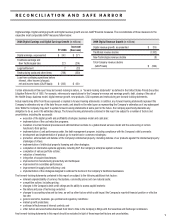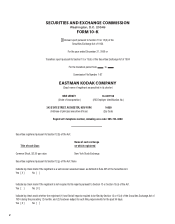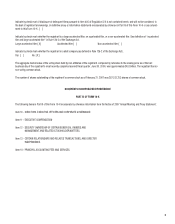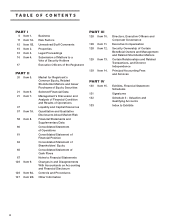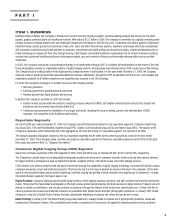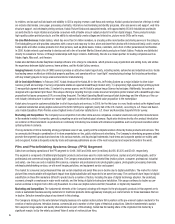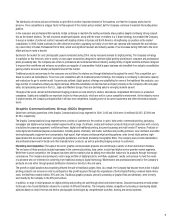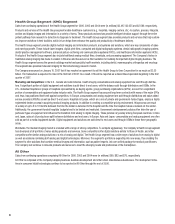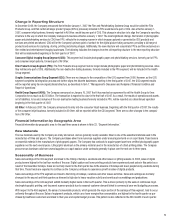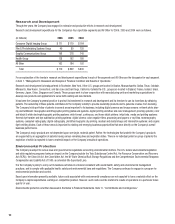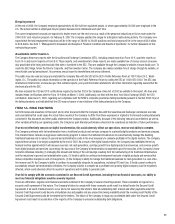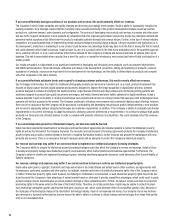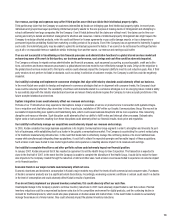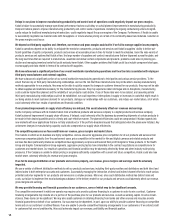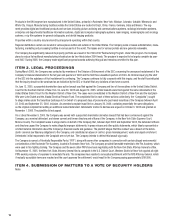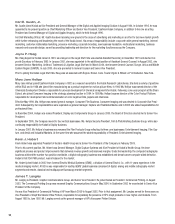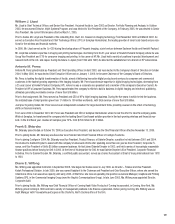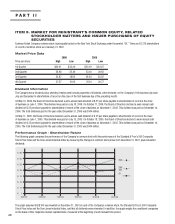Kodak 2006 Annual Report Download - page 18
Download and view the complete annual report
Please find page 18 of the 2006 Kodak annual report below. You can navigate through the pages in the report by either clicking on the pages listed below, or by using the keyword search tool below to find specific information within the annual report.
Employment
At the end of 2006, the Company employed approximately 40,900 full time equivalent people, of whom approximately 20,600 were employed in the
U.S. The actual number of employees may be greater because some individuals work part time.
The current employment amounts are expected to decline more over the next year as a result of the personnel reductions yet to be made under the
2004-2007 cost reduction program. On February 8, 2007, the Company updated the ranges for anticipated restructuring activity. The Company now
expects that the total employment reductions will be in the range of 28,000 to 30,000 positions and total charges will be in the range of $3.6 billion
to $3.8 billion. See Item 7, “Management’s Discussion and Analysis of Financial Condition and Results of Operations” for further discussion on this
restructuring program.
Available Information
The Company files many reports with the Securities and Exchange Commission (SEC), including annual reports on Form 10-K, quarterly reports on
Form 10-Q and current reports on Form 8-K. These reports, and amendments to these reports, are made available free of charge as soon as reason-
ably practicable after being electronically filed with or furnished to the SEC. They are available through the Company’s website at www.Kodak.com. To
reach the SEC filings, follow the links to Corporate, and then Investor Center. The Company also makes available free of charge through its website, at
www.Kodak.com/go/annualreport, its summary annual report to shareholders and proxy statement.
The public may also read and copy any materials the Company files with the SEC at the SEC’s Public Reference Room at 100 F Street, N.E., Wash-
ington, D.C. The public may obtain information on the operation of the Public Reference Room by calling the SEC at 1-800-SEC-0330. The SEC also
maintains an Internet site, at www.sec.gov, that contains reports, proxy and information statements, and other information regarding issuers that file
electronically with the SEC.
We have included the CEO and CFO certifications required by Section 302 of the Sarbanes-Oxley Act of 2002 as exhibits to this report. We have also
included these certifications with the Form 10-K filed on March 2, 2006. Additionally, we filed with the New York Stock Exchange (NYSE) the CEO
certification, dated June 5, 2006, regarding our compliance with the NYSE’s corporate governance listing standards pursuant to Section 303A.12(a) of
the listing standards, and indicated that the CEO was not aware of any violations of the listing standards by the Company.
ITEM 1A. RISK FACTORS
Set forth below and elsewhere in this report and in other documents that the Company files with the Securities and Exchange Commission are risks
and uncertainties that could cause the actual future results of the Company to differ from those expressed or implied in the forward-looking statements
contained in this document and other public statements the Company makes. Additionally, because of the following risks and uncertainties, as well as
other variables affecting our operating results, the Company’s past financial performance should not be considered an indicator of future performance.
If we do not effectively execute our digital transformation, this could adversely affect our operations, revenue and ability to compete.
The Company continues with its transformation from a traditional products and services company to a primarily digital products and services company.
This transformation includes an aggressive restructuring program to reduce its traditional infrastructure to cost-effectively manage the declining
traditional business and to reduce its general and administrative costs to the level necessary to compete profitably in the digital markets. The Company
expects these actions to be largely completed by the end of 2007. As a result of the digital transformation, the Company has established three key
financial metrics against which it will measure success: net cash generation, earnings growth from digital products and services, and revenue growth
from digital products and services. Accordingly, the success of the Company’s transformation is dependent upon the execution of the Company’s trans-
formation initiatives including (1) managing the amount and timing of the cost savings resulting from the restructuring of its traditional infrastructure
and the reductions in general and administrative costs, (2) Kodak’s ability to continue its development and sale of digital products and services that
deliver competitive margins in each of its segments, (3) the Company’s ability to manage the traditional business for cash generation in a cost-effec-
tive manner and (4) the Company’s ability to continue to successfully integrate its acquisitions, including KPG and Creo. If Kodak cannot continue to
successfully execute its transformation initiatives, the Company’s ability to compete as a profitable and growing digital company could be negatively
affected, which could adversely affect its results of operations and its ability to generate cash.
If we fail to comply with the covenants contained in our Secured Credit Agreement, including the two financial covenants, our ability to
meet our financial obligations could be severely impaired.
There are affirmative, negative and financial covenants contained in the Company’s Secured Credit Agreement. These covenants are typical for a
secured credit agreement of this nature. The Company’s failure to comply with these covenants could result in a default under the Secured Credit
Agreement. If an event of default were to occur and is not waived by the lenders, then all outstanding debt, interest and other payments under the
Secured Credit Agreement could become immediately due and payable and any unused borrowing availability under the revolving credit facility of the
Secured Credit Agreement could be terminated by the lenders. The failure of the Company to repay any accelerated debt under the Secured Credit
Agreement could result in acceleration of the majority of the Company’s unsecured outstanding debt obligations.


